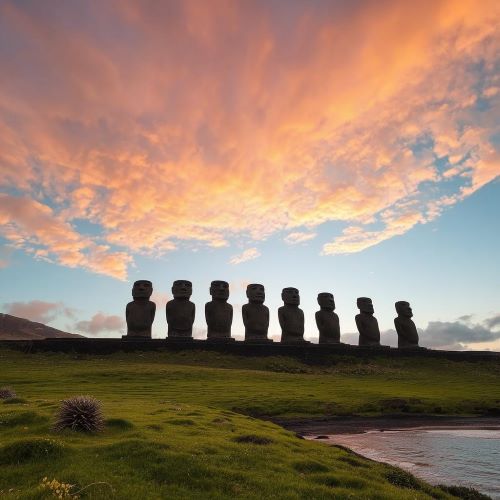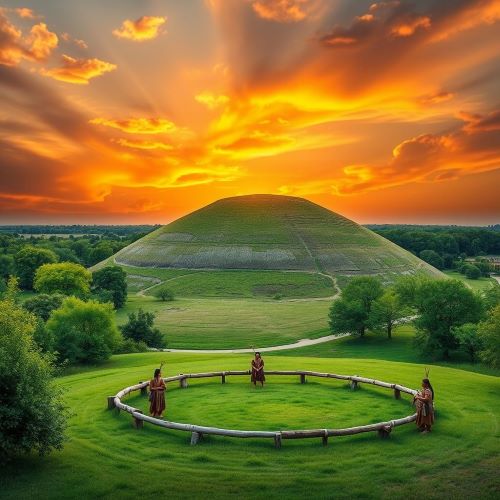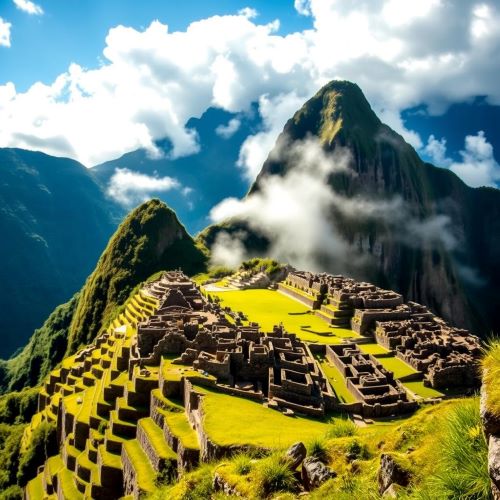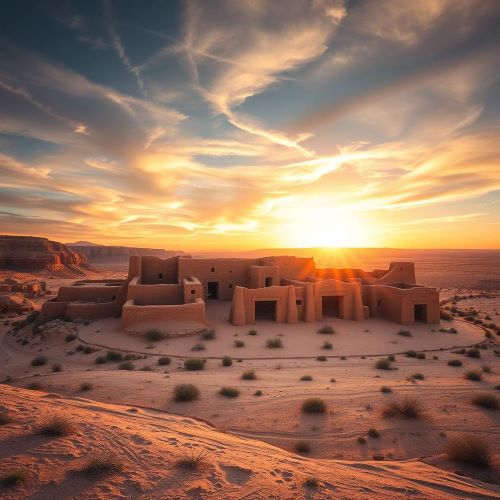Chavín de Huántar : The Ceremonial Altar
At a glance
| Description | |
|---|---|
| Mythology | South American Mythology |
| Country | Peru |
| Closest airport | Huaraz Airport (ATA) |
| Type | Constructed |
| Accessibility | 08/10 |
Introduction
High in the Peruvian Andes lies Chavín de Huántar, a captivating archaeological site that continues to intrigue historians, archaeologists, and spiritual seekers alike. Once a ceremonial hub of the ancient Chavín civilization, this pre-Inca site dates back to as early as 900 BCE. Strategically located between the Cordillera Blanca and Cordillera Negra mountain ranges, and near the meeting point of the Mosna and Huachecsa rivers, it served as more than just a religious complex—it was a cultural beacon for the early Andes.
Its elevated position at over 3,000 meters above sea level not only offered a commanding view of the surroundings but also held symbolic meaning in ancient cosmology. Recognized today as a UNESCO World Heritage Site, Chavín de Huántar offers a fascinating window into the rituals, beliefs, and societal structures of one of South America’s earliest high civilizations.
Connection with Mythology
The heart of Chavín de Huántar pulses with powerful mythological energy. It was here that priests and pilgrims once came to engage with divine forces believed to reside in the stone walls and sacred sculptures. The most iconic of these is the Lanzón, a 15-foot-high granite monolith hidden deep within the temple’s labyrinth. This fearsome deity figure merges human and animal traits—snarling fangs, talon-like claws, and snake-infused hair—each element packed with spiritual symbolism.
According to Andean cosmology, such hybrids weren’t just artistic expressions but representations of divine power and nature’s untamed forces. The jaguar signified the earth and strength, serpents symbolized water and transformation, while bird-like features pointed to the heavens. This rich blend of symbols created a sacred triad that echoed throughout the Andes, reinforcing the Chavín culture’s belief in a universe where all realms—earthly, spiritual, and celestial—are interconnected.
Pilgrims traveled great distances to reach this holy site, seeking answers, healing, or blessings. The ceremonial architecture and hypnotic iconography served to heighten their spiritual experience, making Chavín de Huántar a revered oracle and sanctuary.
Ways to Get There
Reaching Chavín de Huántar is both scenic and adventurous. Most visitors begin their journey in Huaraz, a charming highland city popular with trekkers and mountain climbers. From Lima, you can take a long-distance bus to Huaraz, which takes around 8 hours through dramatic Andean landscapes.
Once in Huaraz, the site is about 75 kilometers away and can be reached by road in roughly 2 to 3 hours. The drive itself is an experience, winding through lush valleys, quaint villages, and high mountain passes. Whether you opt for a guided tour or self-drive, the route enhances the sense of pilgrimage. There are also local buses that run between Huaraz and the town of Chavín, ideal for budget-conscious travelers.
Upon arrival, local guides are available to provide context and stories that bring the ancient stones to life—highly recommended to get the most from your visit.
What to Look For
Every stone at Chavín de Huántar tells a story. Start at the Old Temple, where the sacred Lanzón is housed, and explore its surrounding underground galleries—narrow, maze-like corridors that were built to manipulate sound. These passages were likely used to disorient visitors and amplify the voices of priests, creating a mystical and perhaps even terrifying atmosphere during rituals.
Look out for the tenon heads—stone faces mounted on the outer temple walls. These grotesque visages show transforming human faces into animal forms, possibly representing spiritual metamorphosis or initiatory stages in a ritual process.
Another highlight is the Raimondi Stele, a beautifully carved granite slab that uses visual illusion and mirror symmetry to depict the staff god. Depending on your angle, the figure appears to shift form, a clever example of contour rivalry, a hallmark of Chavín art that reveals deeper meanings to those spiritually prepared.
Also notable are the ceremonial plazas, conch-shell trumpets used in rituals, and finely crafted pottery and goldwork found in excavations—evidence of both technical skill and spiritual intent.
Need a place to stay? Book your hotel room now!
Importance in cultural history
Chavín de Huántar wasn’t just a local ceremonial site—it played a central role in shaping religious and artistic traditions across ancient Peru. Its influence spread far beyond the highlands, reaching coastal and jungle communities through trade and pilgrimage routes. The site’s iconography, mythological themes, and ceremonial practices were adopted and adapted by later cultures, such as the Paracas and Nazca.
It is widely regarded as one of the earliest centers of religious authority in the Andes, possibly even functioning as a political center where priest-elites wielded both spiritual and temporal power. The integration of architecture, acoustics, and symbolism reflects a deep understanding of how to inspire awe and maintain social order through divine association.
Today, the site continues to offer invaluable insights into how early Andean societies conceptualized the cosmos and their place within it, laying the foundation for millennia of cultural development in the region.
Best time to travel
If you’re planning a trip to Chavín de Huántar, timing is key. The best time to go is during the dry season, from April to October, when the skies are clear and roads are more reliable. During these months, the crisp air and vivid mountain scenery make for ideal exploration conditions.
Many local festivals also take place during this period, allowing visitors to experience modern echoes of ancient Andean rituals. These celebrations often include music, traditional dress, and processions that, while evolved, still reflect the spiritual heritage rooted in places like Chavín. Outside of the dry season, travel can become tricky due to heavy rains and muddy roads, which might impact access and comfort.
Source
Dr. Sarahh Scher. (n.d.). Chavín de Huántar – Smarthistory. https://smarthistory.org/chavin-de-huantar/
Chavín de Huántar – Wikipedia. (2004). https://en.wikipedia.org/wiki/Chavin_de_huantar
Facts About the Chavín Culture | Valencia Travel Cusco. (2025). https://www.valenciatravelcusco.com/passion-passport/interesting-facts-about-the-chavin
Chavín de Huántar | archaeological site, Peru – Britannica. (n.d.). https://www.britannica.com/place/Chavin-de-Huantar
Chavín de Huántar, Peru – Google Arts & Culture. (n.d.). https://artsandculture.google.com/story/chav%C3%ADn-de-hu%C3%A1ntar-peru-cyark/9AXxaBwv7bFPKA?hl=en
From Chavin to the Inca, a timeline of the Central Andes. (n.d.). https://www.britishmuseum.org/exhibitions/peru-journey-time/timeline-central-andes-south-america
Frequently Asked Questions
Lorem ipsum dolor sit amet, consectetur adipiscing?
Lorem ipsum dolor sit amet, consectetur adipiscing elit. Praesent convallis vestibulum justo, ac tincidunt nunc vehicula quis. Nullam id dolor quis orci malesuada feugiat. Curabitur aliquet libero at urna ullamcorper, ac ultricies nulla dapibus.
Lorem ipsum dolor sit amet, consectetur adipiscing?
Lorem ipsum dolor sit amet, consectetur adipiscing elit. Praesent convallis vestibulum justo, ac tincidunt nunc vehicula quis. Nullam id dolor quis orci malesuada feugiat. Curabitur aliquet libero at urna ullamcorper, ac ultricies nulla dapibus.
Lorem ipsum dolor sit amet, consectetur adipiscing?
Lorem ipsum dolor sit amet, consectetur adipiscing elit. Praesent convallis vestibulum justo, ac tincidunt nunc vehicula quis. Nullam id dolor quis orci malesuada feugiat. Curabitur aliquet libero at urna ullamcorper, ac ultricies nulla dapibus.
Lorem ipsum dolor sit amet, consectetur adipiscing?
Lorem ipsum dolor sit amet, consectetur adipiscing elit. Praesent convallis vestibulum justo, ac tincidunt nunc vehicula quis. Nullam id dolor quis orci malesuada feugiat. Curabitur aliquet libero at urna ullamcorper, ac ultricies nulla dapibus.
Lorem ipsum dolor sit amet, consectetur adipiscing?
Lorem ipsum dolor sit amet, consectetur adipiscing elit. Praesent convallis vestibulum justo, ac tincidunt nunc vehicula quis. Nullam id dolor quis orci malesuada feugiat. Curabitur aliquet libero at urna ullamcorper, ac ultricies nulla dapibus.








